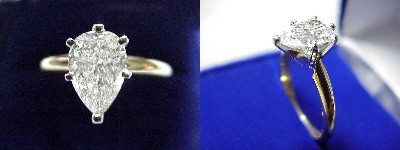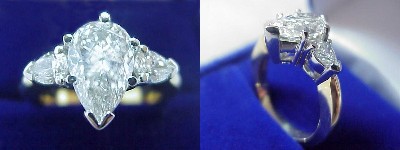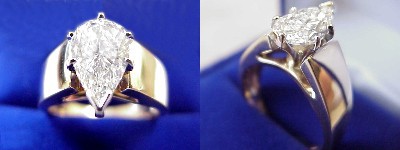The technical name of the pear is “pear-shaped modified brilliant,” based on its shape and modifications of the traditional round brilliant configuration.
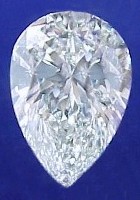 The pear shape is a combination of the round and marquise brilliant cuts and usually has the 58 facet brilliant pattern, but can be cut with different numbers of pavilion mains of 8, 7, 6, or 4 facets. The teardrop shape has a round or oval shape on half the facet pattern while the other half resembles a marquise with the sides tapering to a point.
The pear shape is a combination of the round and marquise brilliant cuts and usually has the 58 facet brilliant pattern, but can be cut with different numbers of pavilion mains of 8, 7, 6, or 4 facets. The teardrop shape has a round or oval shape on half the facet pattern while the other half resembles a marquise with the sides tapering to a point.
Some of the world’s largest and most famous diamonds were cut in to the pear shaped brilliant cut. Mined in the early 1990s, the De Beers Millennium Star is so large and flawless that it is hard to put an accurate price on it. Cutters spend three years transforming the stone into what is now the world’s only internally and externally flawless, pear-shaped diamond weighing 203 carats. Perhaps the most famous romantic diamond gift in modern times was the 69 carat Taylor-Burton pear-shaped diamond given by Richard Burton to Elizabeth Taylor.
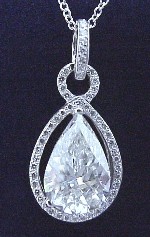 As with all fancy shapes, the ultimate shape of the finished diamond is determined by the characteristics of the rough crystal. More than other fancy shapes, length-to-width ratio is a matter of taste when it comes to pears shapes. As pears may be used for engagement rings, graduated layouts for pendants for necklaces, dangles in earrings, and integral parts of custom designs, a wide variety of shapes is considered desirable. For example, the elongated pear-shaped brilliant shape that is too narrow for most engagement rings lends itself very well for dangling earrings.
As with all fancy shapes, the ultimate shape of the finished diamond is determined by the characteristics of the rough crystal. More than other fancy shapes, length-to-width ratio is a matter of taste when it comes to pears shapes. As pears may be used for engagement rings, graduated layouts for pendants for necklaces, dangles in earrings, and integral parts of custom designs, a wide variety of shapes is considered desirable. For example, the elongated pear-shaped brilliant shape that is too narrow for most engagement rings lends itself very well for dangling earrings.
A tip at the pointed end of the pear brilliant with insufficient girdle thickness presents durability problems, while an extremely thick girdle can cause difficulty in setting and hides the weight below the girdle where you can not see it.
 In the pear brilliant, as with marquise shapes and other elongated fancy shapes, there is an increased likelihood of having a “bow tie.” This is a dark area in the shape of a man’s bow tie that occurs when the angles of the cut are not optimum. This facet misalignment can detract from the brilliance, especially if it is an exaggerated or overly dark bow tie effect.
In the pear brilliant, as with marquise shapes and other elongated fancy shapes, there is an increased likelihood of having a “bow tie.” This is a dark area in the shape of a man’s bow tie that occurs when the angles of the cut are not optimum. This facet misalignment can detract from the brilliance, especially if it is an exaggerated or overly dark bow tie effect.
 Advice: In a pear, look for a well-shaped head and even shoulders with a length-to-width ratio of 1.45-1.70. Pear-shaped diamonds work great for pendants and drop earrings. We seek pear shaped diamonds with depth 57-65.4% and table 52-64%. Seek minimal bow tie effect. We recommend at least I color and SI1 clarity for pear shaped diamonds.
Advice: In a pear, look for a well-shaped head and even shoulders with a length-to-width ratio of 1.45-1.70. Pear-shaped diamonds work great for pendants and drop earrings. We seek pear shaped diamonds with depth 57-65.4% and table 52-64%. Seek minimal bow tie effect. We recommend at least I color and SI1 clarity for pear shaped diamonds.
The following photos are only a sampling of pear cut diamond ring styles. Hundreds of mounting styles look great with pear cut diamonds so just email us a picture of the style you like and we can get you a price quote. You can also check out our Designer Gallery for pictures of mountings from some of our suppliers.
When set in a ring, the pear shape diamond is usually worn with the the point extending toward the finger’s nail.


